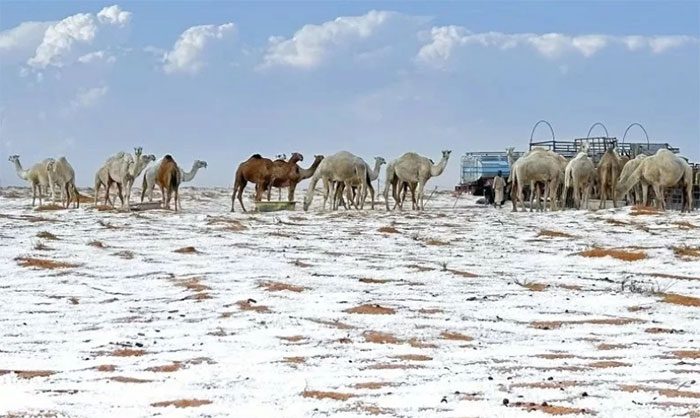The Al-Nafūd Desert in Al-Jawf has recorded snowfall for the first time, blanketing the sand dunes in white and attracting many curious onlookers.
According to the Saudi Press Agency, the snowfall on November 3 covered the entire Al-Nafūd Desert in a thick layer of white. On social media platform X, images of vehicles lined up in the snowy desert and camels traversing the icy landscape have been widely shared.

Snowfall in the Saudi Arabian desert for the first time. (Source: AP).
The national meteorological center of the United Arab Emirates (UAE) reported that this unusual weather phenomenon originated from a low-pressure system over the Arabian Sea.
Temperatures in this region can soar up to 55 degrees Celsius, making the sudden appearance of snow and ice “surprising.” This is the first time such an event has been recorded since data collection began.
The British Metro reported that the low-pressure area brought moist air to this arid location, causing thunderstorms, hail, and heavy rainfall across Saudi Arabia and the UAE.
The meteorological agency has advised residents to prepare for harsher weather. This abnormal condition could reduce visibility and disrupt travel in the desert.
Contrary to the belief that deserts are only hot and sandy, these areas can indeed experience snowfall. The Sahara Desert has recorded several frost events over recent decades.
The website The Conversation explained that snow formation requires cold temperatures and moist air. The recent low-pressure system may have pulled cool, moist air towards the Al-Nafūd Desert, leading to the snowfall.
Snow can also form in higher elevations, such as the Atlas Mountains in Morocco. If the air is cold enough, moisture can freeze into snow crystals, covering the area in white. The World Bank noted that Western Asia is one of the regions most vulnerable to climate-related impacts.
The Al-Nafūd Desert is not the only place experiencing unusual weather. Firstpost reported that Riyadh, the capital of Saudi Arabia, is also grappling with heavy rainfall and flooding.


















































